Since the end of the last recession, Seattle has consistently ranked among the fastest growing major US cities. Is all that growth leaving the Emerald City less emerald?
Not really.
Seattle’s best new data on the change in tree canopy over time does show a 6 percent decline between 2007 and 2015. Here’s the catch, though: most of the confirmed tree loss happened on land reserved for detached houses, the single-family zones that cover over half the city but where population has barely budged for decades.
Meanwhile, the same study found no statistically significant change in tree canopy where the growth actually has been happening: the land zoned for commercial buildings and multifamily housing that absorbed the vast majority of Seattle’s new apartments, offices, and stores.
From 2007 to 2015, all that construction helped make room for 76,000 additional residents and 65,000 new jobs—like adding about half of the neighboring city of Bellevue. It’s a remarkable success story: Seattle increased its stock of homes by 14 percent, confined almost completely to the 18 percent of city land where multifamily housing is allowed—with no measurable impact on trees!
These latest tree findings corroborate a study of Seattle’s commercial centers from 1993 to 2014 that detected tree canopy increases in six of the ten centers studied, and no changes in the remaining four. Another study estimated that Seattle’s citywide tree canopy rose by 2 percent between 2002 and 2007, a period during which the city also grew, albeit not as rapidly as in the current boom.
In 2007, Seattle adopted a goal of 30 percent tree canopy cover by 2037. The city’s most rigorous analysis to date pegged it at 28 percent in 2016. An alternate measurement method showed 33 percent in 2007 and 31 percent in 2015. In 2014, University of Washington researchers applied three different methods that yielded 26 or 30 percent in 2009, and 29 percent in 2012. The varied results highlight the difficulty of measurement, but together these assessments indicate Seattle is already likely close to hitting its 30 percent goal.
All told, Seattle’s tree studies demonstrate that, contrary to what the casual observer might assume, cities can build up—a lot!—and still keep lots of trees around. And that’s great news, because trees bring immense value to city dwellers in numerous ways.
The best available evidence indicates no need for drastic policy measures that could risk thwarting homebuilding to save trees. Even if the data did show some tree loss caused by the construction of apartment buildings, though, Seattle would be ill-advised to reflexively prioritize trees over new homes in a city suffering from a housing shortage that’s been inflating rents and prices ever higher.
Tree preservation rules that would sacrifice new urban homes—that is, housing that can accommodate a lot of people on a small amount of land—becomes even more indefensible when you factor in the resulting shift of development pressure toward places where low-density housing construction obliterates far more trees.
In short, Seattle doesn’t have anything like a tree crisis, and concern over trees is no excuse to stop welcoming more new neighbors to the city. The place growing cities can make room for more trees is the publicly-owned right-of-way, where Seattle’s 500,000 curbside parking spaces alone cover land that could hold perhaps one million trees and boost the city’s tree population by two thirds. Cities throughout Cascadia and beyond can opt to take back underutilized pavement from cars instead of further squeezing much-need housing options. Read on for the longer story.
(Click on the photo below to see a time lapse of the three images.)

Downtown Vancouver, BC, as seen from the Cambie bridge in 1978, 2003, and 2017, illustrating how cities can densify and add trees at the same time. (CLICK TO VIEW A TIME LAPSE OF THE THREE IMAGES). 1978 photo by Patricia French, 2003 and 2017 photos by Andy Coupland, used with permission.
We know that urban trees are valuable yet we haven’t been very good at monitoring them
Much has been written about the wide ranging and enormous benefits provided by urban trees: they sequester carbon, absorb stormwater, improve air quality, mitigate the heat island effect, calm car traffic, and improve mental health; plus they’re just plain beautiful. Given the well-recognized high value of urban trees, though, there’s a surprising lack of reliable data to inform comparisons between cities and trends over time.
To help fill that void, researchers at MIT recently developed a new metric derived from Google street view images called the Green View Index (GVI) that quantifies how much tree cover a person at street level experiences. Of 27 international cities Seattle’s GVI came in at 20 percent, ranking in the middle of the pack. For comparison, Vancouver, BC, was 26 percent; Sacramento was 24 percent, Boston was 18 percent; Los Angeles was 15 percent; and Paris was 9 percent.
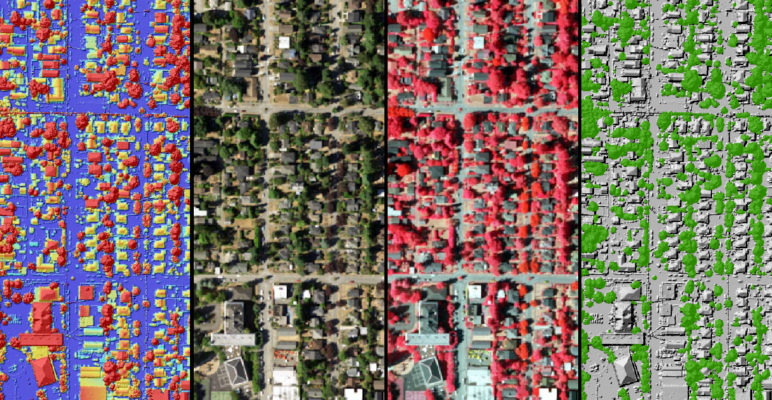
Three different ways to measure tree canopy from left to right: LiDAR, aerial photography, and color infrared, with Seattle’s final LiDAR-based tree canopy result mapped on the far right. Source: City of Seattle.
The most common tree-monitoring yardstick is canopy cover—that is, the portion of the ground that is covered by trees’ branches and leaves when looking down from above. Canopy is usually measured by one of two methods: aerial LiDAR (light detection and ranging) that creates a 3D map of trees; and manual observation of satellite aerial photographs. The two methods tend to deliver differing results.
A comparison of Cascadia’s three major cities—Vancouver, BC, Portland, and Seattle—illustrates the inconsistency. Based on LiDAR, Vancouver’s tree canopy cover was 18 percent in 2013, and Seattle’s was 28 percent in 2016. (Remember, on the Green View Index, Vancouver scored higher than Seattle.) Based on aerial photographs, meanwhile, 2015 coverage for both Portland and Seattle was 31 percent.
Portland’s data indicates canopy rose from 27 percent in 2000 to hit that 31 percent in 2015. In contrast, Vancouver’s LIDAR data showed a decline of 23 to 18 percent from 1995 to 2013—that’s a full one fifth loss of canopy. Based on aerial photos, Seattle measured a smaller decline of 33 to 31 percent from 2007 to 2015, and an earlier study found much lower coverage but with a slight increase over time from 22.5 percent in 2002 to 22.9 percent in 2007.
That these three Cascadian cities—with similar age, climate, environmental ethic, and zoning that reserves about half of their land for detached houses—would report such divergent canopy trends underscores that it’s actually a hard thing to measure reliably, and that they need better methods.
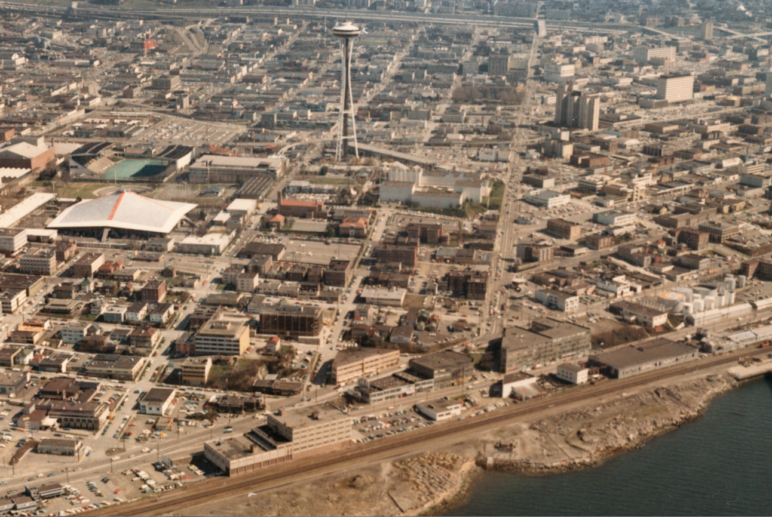
May 1970 aerial photo of Seattle’s Uptown neighborhood at the north edge of downtown illustrating lack of tree canopy coverage. Photo from City of Seattle Municipal Archives Digital Collection, public domain. Click photo to enlarge.
Busting Seattle’s Myth of the Green Seventies
What’s worse, bad data can take on a life of its own. Seattle’s 2007 Urban Forest Management Plan states that “today, about 18 percent of the city is covered by tree canopy as compared with 40 percent just 35 years ago.” Turns out that statement is bunk. Apparently, the 40 percent data point for 1972 was based on a misinterpretation of a 1998 study that was assessing the region, not just Seattle proper. And the 18 percent measured for 2002 was a blatant outlier on the low end, also unreliable.
It’s hard to imagine how a claim that the city lost over half of its tree canopy since the 1970s wouldn’t have failed the laugh test with anyone who had been around during those decades. In the 1970s, tree canopy in much of Seattle was still recovering from historic clear cuts and development, as shown in the accompanying photos, and the city’s tree planting efforts had barely begun. Yet somehow Seattle proceeded to lose something like a million and a half more trees? Furthermore, as the city acknowledges, “natural growth of mature trees and plantings tend to offset canopy loss.” Blaming growth doesn’t hold up either: Seattle lost population during the 1970s and didn’t surpass its late 1960s peak until the mid-1990s.
City authorities have never issued a correction, and so the myth of tree decimation lives on, repeated as recently as last year in Seattle Magazine: “In the 1970s, Seattle was mantled with trees, with about 40 percent canopy cover… but as the number of city inhabitants has increased, we’ve shed at least a quarter of that protective green veil.” Nope.
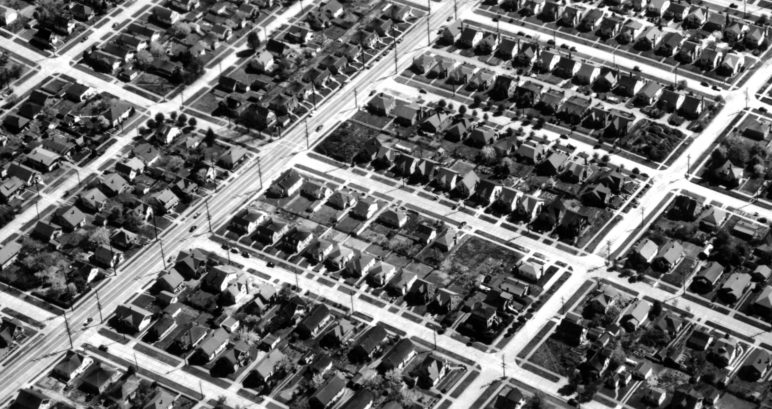
1947 aerial photo of Seattle’s West Woodland neighborhood illustrating how most of the trees were cleared to make way for the construction of new houses and roads. Photo from City of Seattle Municipal Archives Digital Collection, public domain. Click photo to enlarge.
What the evidence shows: Seattle’s rapid growth has not caused measurable tree loss
The best available evidence busts the myth. The table below presents Seattle’s LiDAR-based canopy cover measurements for 2016, broken out by land use category (“management unit”). Overall, the city’s tree cover is just below the goal of 30 percent by 2037, and most categories are near or exceed their targets. Note that single-family zones, according to this method of measurement, cover 56 percent of the city and provide nearly two thirds of the total canopy cover.
Because Seattle has no comparable LiDAR data from prior years, analysts relied on sampled, manual observation of aerial photography to assess canopy change over time in 2007, 2010, and 2015, as summarized in the chart below. Compared to LiDAR, the aerial photography results are higher across the board. (See this University of Washington study for a review of previous Seattle tree canopy assessments.)
City-wide (magenta bars), the data show a statistically significant decline from 33 to 31 percent between 2007 and 2015, and that change is mirrored in a statistically significant drop from 39 to 36 percent in single family zones (yellow). The only other statistically significant change occurred in institutional areas, falling from 28 to 25 percent, but that land area constitutes only 2 percent of the city.
The 3 percentage point decline in single-family canopy is equivalent to a loss of 8 percent. Assuming for approximation that in 2007 single-family accounted for 63 percent of the city’s canopy cover (as it did in 2016), the 8 percent loss in single-family caused a 5 percent loss city-wide. So the single-family decline accounts for about four fifths of the observed total city-wide loss of 6 percent.
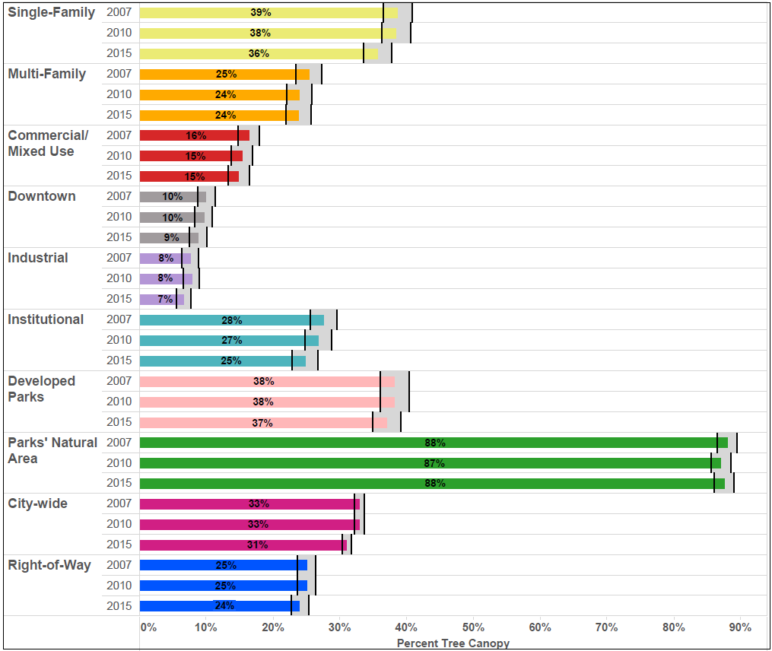
Results from Seattle’s 2015 aerial photo-based assessment of tree canopy change over time. Gray shaded areas represent the margin of error. Source: City of Seattle.
What is happening in Seattle’s single-family zones to cause the tree canopy loss? The city report doesn’t venture to guess. As already noted, population in Seattle’s single family zones has been mostly locked in amber, even during the current high-growth decade. One likely culprit is teardowns replaced by McMansions that take out trees because they cover more lot area, but that’s a small fraction of the city’s total number of houses. Some homeowners cut trees for views or safety reasons, but that also doesn’t seem prevalent enough to be a main cause. Even though the measured decline in Seattle’s single-family zones was statistically significant, is it possibly just bad data? Indeed, the analysts who conducted the study caution that:
“A number of factors could cause differences in canopy estimates including limitations of using a sample‐based approach and that historical imagery from Google Earth is not collected at the same time of day, causing shifts of tree canopy location.”
Where the growth happened and the tree loss didn’t
Nearly all of Seattle’s population and job growth occurred in the multifamily, commercial/mixed-use, and downtown areas where the data show no statistically significant changes in canopy between 2007 and 2015 (see chart above). There is a general trend of slight loss in the measured values, but again, keep in mind the above-quoted caution about error-inducing anomalies in the aerial images.
To restate: from 2007 to 2015 Seattle fit 76,000 new residents, 65,000 new jobs, and 14 percent more housing stock into about one fifth of its land, without causing a measurable decline of tree canopy.
This lack of tree loss corroborates a 2014 study of Seattle’s “urban villages”—designated commercial centers and transit hubs that are zoned for higher capacity to absorb housing and job growth. The study compared 1993 to 2014 and detected tree canopy increases in six of the ten urban villages studied, and no statistically significant changes in the remaining four. During those two decades Seattle’s 32 urban villages captured three quarters of the city’s new housing.
Likewise, Portland attributes its measured canopy gain of 12 percent over 15 years to areas of the city that actually grew, writing that, “residential, commercial, and industrial zones are more likely to undergo development changes and are likely to have more opportunities for planting and growing trees.” It makes sense when you consider that new construction in large, built out cities usually replaces spent buildings or parking lots that have few if any trees to begin with.
Testifying to the success of Seattle’s street tree efforts, city-owned rights-of-way (streets and parking strips, mostly, plus sidewalks that are not on private land) provide an impressive 22 percent of the city’s tree cover (see table above). Rights of way cover a whopping 27 percent of the city, but trees are planted on only a sliver of that area, usually just a narrow strip between sidewalk and curb. The observed loss of canopy in rights of way from 2010 to 2015 (dark blue bars in the chart above) seems particularly suspect: developers, homeowners, and multiple city programs are continually planting new street trees in the rights of way, while the existing trees are growing.
Of course, canopy coverage alone doesn’t tell the whole story of the health or value of a city’s trees.
Conifers, for example, are more effective than deciduous trees at capturing stormwater runoff. Seattle’s 2007 Urban Forest Management Plan notes that “forested parklands have too few conifers, too many deciduous trees, and too many non-native invasive plants when compared with native ecosystems.”
Street trees may not thrive in hostile, space limited locations. Furthermore, Seattle’s trees are inequitably distributed, with less canopy in areas where “more of the population tends to be people of color and have lower incomes.” Seattle has room to improve in specific areas, but canopy coverage is still the key metric for monitoring trees as the city grows.
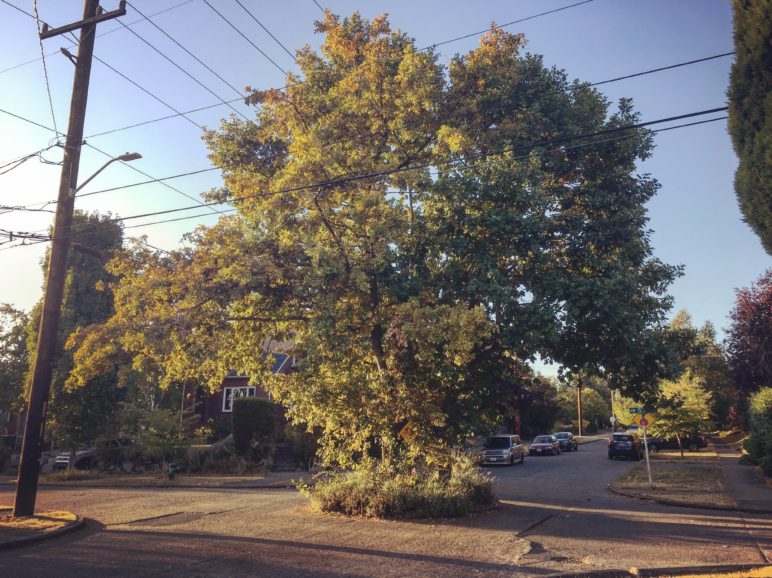
Over the past 30 years Seattle has installed over 1,000 traffic circles that take back part of the right-of-way in intersections in residential neighborhoods to create space for trees and other greenery, and calm car traffic at the same time. Photo by Dan Bertolet, used with permission.
The tension between tree preservation rules and housing affordability
Overall, the tree canopy evidence indicates that Seattle has been doing a remarkable job of balancing growth and trees. Credit is due to numerous city tree programs and protection regulations, as well as non-profits and dedicated individuals. Most of these efforts have been focused on street trees, which are currently being inventoried by Department of Transportation analysts who expect the total count to hit 200,000 or so. Street trees are especially beneficial to the experience of pedestrians, as gauged by the MIT Green View Index, noted above.
Despite the evidence, however, the myth is strong: the average person-on-the-street likely assumes that rampant development is stripping Seattle of its trees. Concern over loss of trees is one of the most common reasons people give for opposing homebuilding projects or rule changes to allow more homes.
The risk is that political pressure will beget overzealous tree protection rules that make it harder or more costly to build new homes. And that’s the opposite of what’s needed in a city where a shortage of housing has driven rents skyward; where it’s becoming harder and harder for people with low incomes to find homes they can afford. When tree preservation sacrifices new homes, those at the bottom struggling to pay their rent are the ones who bear the burden.
A good compromise policy would offer an incentive to homebuilders to offset the cost of saving trees. For example, in 2017, Seattle adopted new design review rules that grant an allowance for a larger or taller building in exchange for retention of exceptional trees. In contrast, Seattle’s proposed Residential Small Lot zoning would add tree planting requirements with no balancing incentive. Such rules may increase the tree count but they will also make homebuilding—and therefore homes—more expensive.
Because single-family areas are where most of the city’s canopy is located, and also where it appears to be declining most, Seattle City Council is currently considering new tree preservation rules for single-family zones. The proposed regulations would require homeowners to replace trees they remove to maintain canopy coverage or pay a fee that would then fund planting compensational trees elsewhere. The proposal is fair in that it asks property owners who inefficiently use land to pitch in for trees. But the rules could backfire on Seattle’s affordable housing goals in the case of trees that need to be taken out to make room for a new backyard cottage. Tree removal fees could be the financial straw the breaks the camel’s back, dissuading an owner from building a new home.
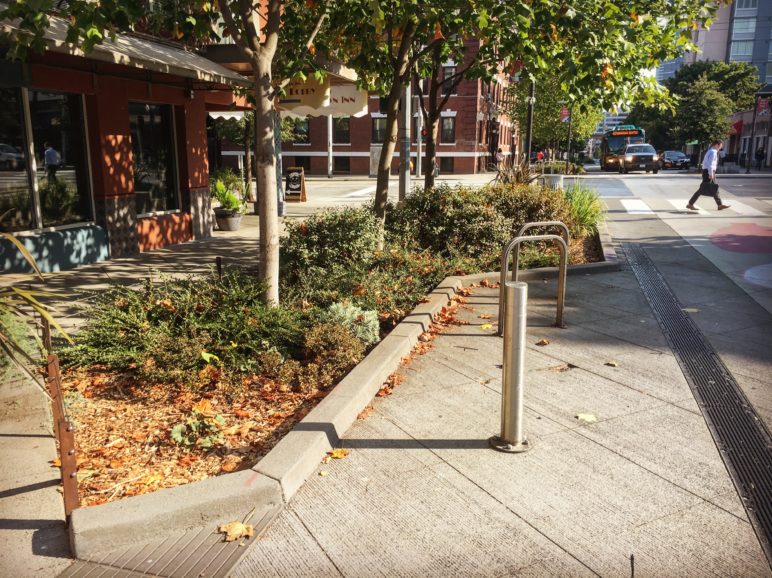
On Seattle’s Bell Street Park, the city narrowed the portion of the street devoted to car lanes and repurposed the right of way for trees, bike parking, and expanded sidewalks. Photo by Dan Bertolet, used with permission.
The place to add trees is in the publicly-owned right-of-way
In any growing city, conflict between adding homes and preserving trees is inevitable. Seattle’s next assessment may show definitively that canopy is declining. The city’s housing shortage isn’t going away any time soon, and one of the best ways policymakers could help ameliorate that shortage is by relaxing single-family zoning to allow more homes. But that, of course, threatens the two thirds of Seattle’s tree canopy in single-family zones.
From the regional perspective, higher density housing is always a win for trees. Compared to a typical new apartment building in a city center, low-density housing on the metropolitan fringe consumes far more land per home, and that invariably means far more trees disappear—trees that may also have been part of larger functioning ecosystem. Limiting new homes in the city core to preserve trees pushes homebuilding to outlying areas, accelerating the eradication of not only trees, but forests.
But that doesn’t make it any less important to maximize trees in urban areas. How can cities welcome both new neighbors and trees? The most promising solution lies in the publicly owned right-of-way—the land set aside mostly for pavement. The opportunity is enormous: Rights of way cover at least a quarter of a typical city’s land. The small fraction of Seattle’s right of way devoted to trees currently provides over a fifth of the city’s canopy coverage.
As described in this Sightline series, Cascadia’s three major cities are already making progress on greening their public roadways. To achieve their urban forestry goals they can step up these efforts with a focus on adding trees.
Consider: in 2007, Seattle had an estimated 1.4 million trees. The city has roughly 500,000 curb-side parking spaces . Assuming two trees fit on a space, that’s room for 1 million trees. About half of those spaces are in single-family zones.
Similarly, Seattle has about 15,000 street intersections, two thirds of which are in single-family zones. Installing curb bulb-outs one parking space long on every single-family corner (eight spaces per intersection) would make room for 160,000 trees. This reconfiguration would also improve pedestrian safety by reducing the street crossing width. And it would reinforce the revolution that’s brewing in transportation, as bikes, transit, walking, autonomous electric robo-taxis, more-compact neighborhoods, and even electric scooters make private car ownership less important or valuable.
Of course no city will ever convert anything close to all of its on-street parking spaces, or plant 16 trees at every one of its neighborhood intersections, but the upper limit illustrates the huge potential. In principle, Seattle could boost its current tree count by two thirds just by planting in its curb parking spaces. The implication is that the real tradeoff cities face is not between trees and housing for people but between trees and free storage for private cars.
In addition to parking, most North American cities originally laid out their roads with the car in mind, and so they tend to have lots of pavement flab that could be reclaimed for trees, though it’s difficult to estimate that area. Seattle’s Pavement to Parks Program has begun picking off pieces of excess roadway to create small paved parks. Spaces like these throughout the city could instead hold trees. To take the idea further, cities can consider taking back entire roads in select locations to create car-free mini-parks filled with trees.
Cities can welcome new residents and grow greener at the same time
Whenever any growing city proposes loosening rules to allow more homes, opponents invariably raise the issue of tree loss. But that’s a false choice. Seattle’s latest data on tree canopy cover demonstrate that cities can rapidly densify without sacrificing trees. And even if the construction of new homes reaches the intensity where it causes tree loss, it doesn’t justify draconian tree protection rules that could thwart homebuilding and exacerbate the shortage of housing that’s driving Seattle rents more and more out of reach of those on the low end of the economic ladder.
Fortunately, Seattle and other North American cities facing the same affordability challenge have a big escape hatch for accommodating trees: the publicly owned right-of-way—the quarter of urban land typically devoted mostly to pavement, mostly for motor vehicles. By repurposing underutilized land devoted to cars in the right-of-way to land for trees, cities can welcome more people and grow greener at the same time.

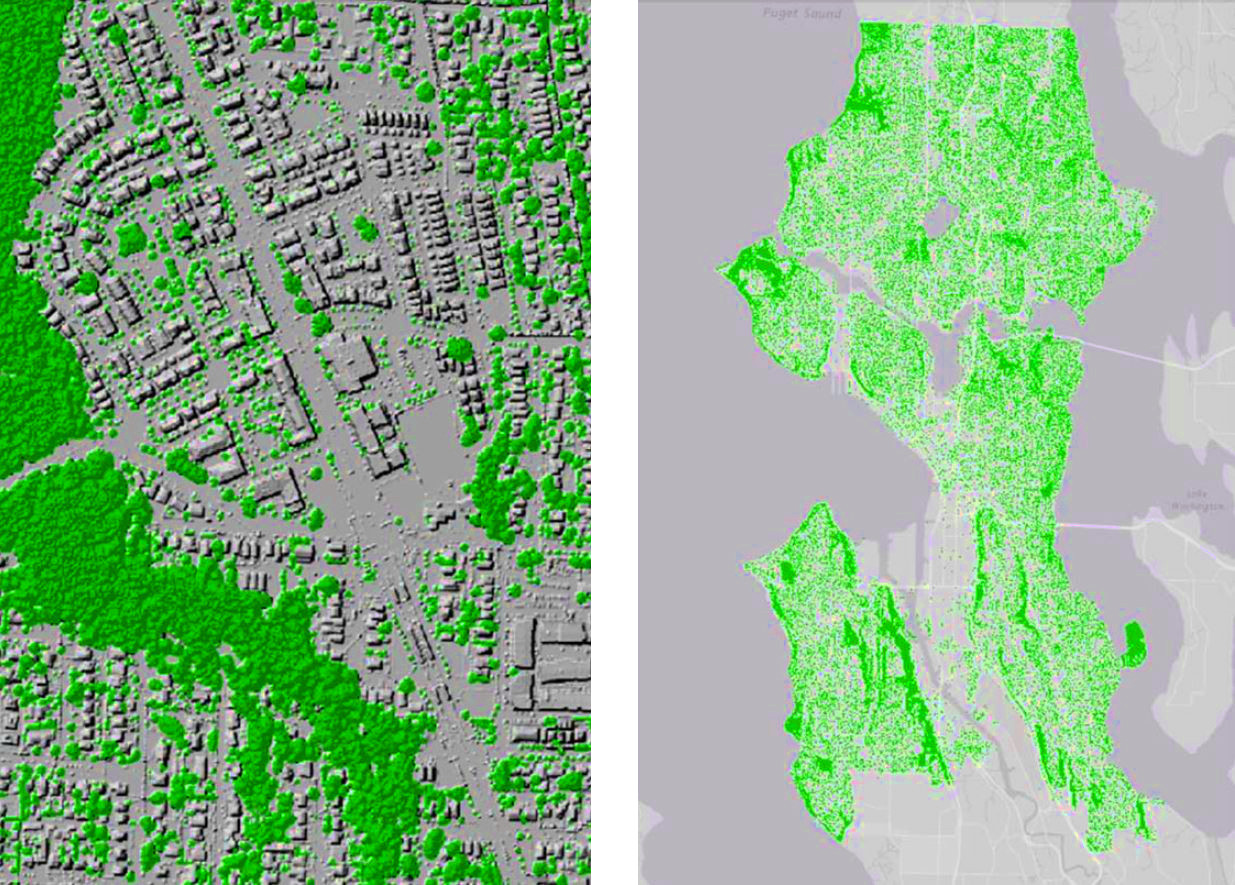
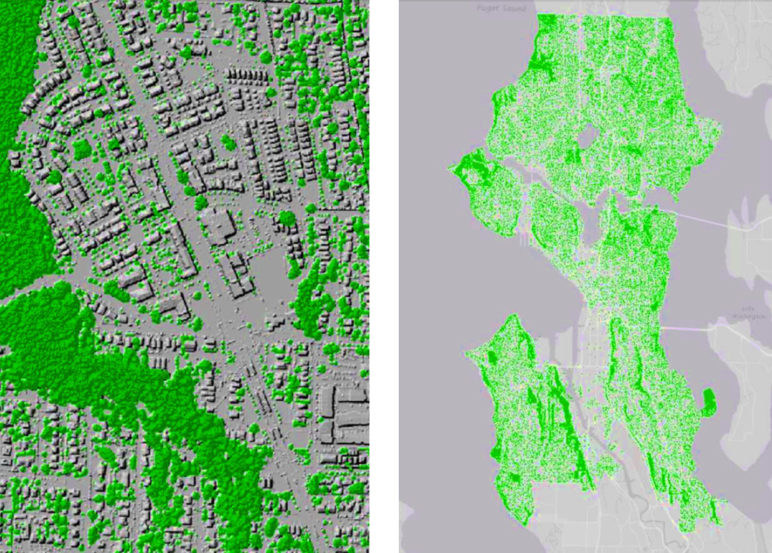
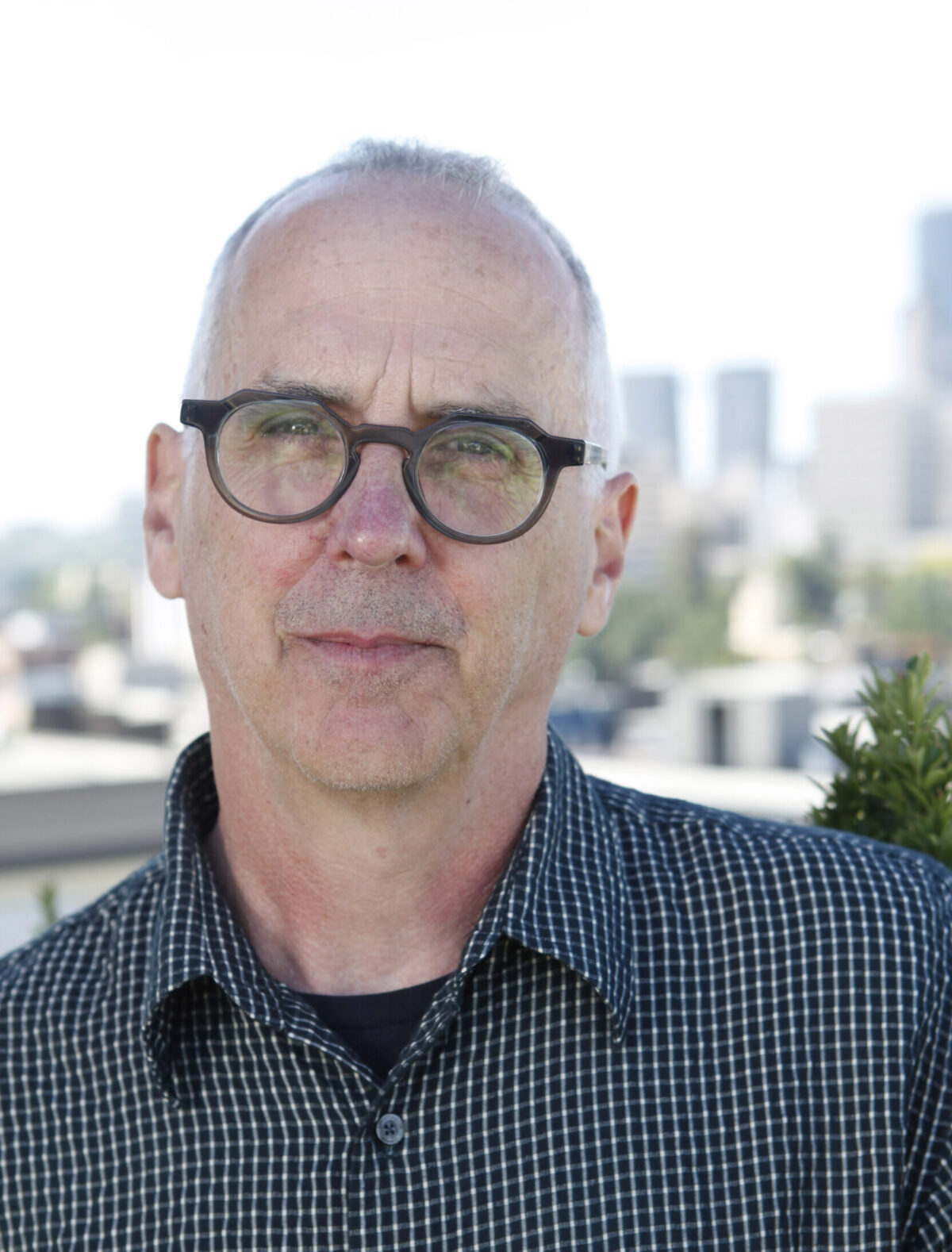
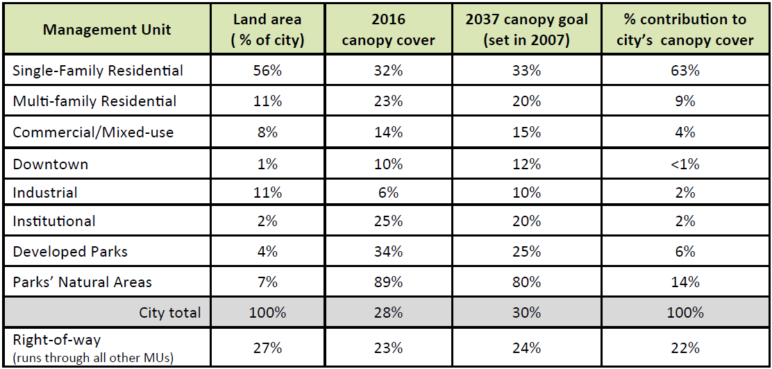






Tom Civiletti
Maintaining canopy is not what I see here in the Portland suburb of Oak Grove. We are losing many more trees than we are gaining housing units.
Dan Bertolet
Tom –
It wouldn’t surprise me that some areas may be losing while others are gaining, but the tree canopy metric is an average, but the data show a net increase.
Also keep in mind that the Portland planners believe that tree canopy is increasing in the areas of the city where redevelopment has been happening.
Jeff Ramsey
Hi Dan,
For the record, as one of the City of Portland staff who worked on the report you cite, no one here is saying that tree canopy is increasing in the areas of the city where redevelopment is happening. That question is an interesting one, but far outside the scope of our study. While canopy has increased over the past 15 years in residential zones, we don’t break that down into the zoning types that have experienced the most development.
Dan Bertolet
Thanks for the clarification, Jeff.
My interpretation was based on the observed 4.2 percent canopy increase in commercial zones along with an assumption that as in Seattle, in Portland most of the new apartments have been built in commercial zones (along with all the new office construction).
Are you saying my assumption is wrong, that most of Portland’s growth happened in residential zones?
Jeff Ramsey
Not to get too far in the weeds, but our analysis included multi-dwelling zones, where many of our new apartments are being built, in with residential. So, while we have seen a significant increase in canopy in residential zones over the past 15 years, we can’t say with any certainty that canopy is increasing in those portions of the zones where development is happening. In Portland, we also have a lot of infill development, where single family homes are being taken out and replaced with larger footprint duplexes and other higher density designs within single family zones. Possibly more so than in Seattle. Again, we can’t say to what extent this is impacting canopy, since our analysis didn’t go down to that scale. (It would be a great project for any grad students out there!)
Hope this helps clarify the unknowns, and I appreciate the discussion!
Tom Civiletti
It is certainly a positive that Portland requires trees be planted with new development, but I question how accurate a measure of urban trees is provided by gauging tree canopy from aerial photos. Trees are essentially vertical lifeforms. Replacing a mature 4′ diameter one with saplings spaced every 25′ is not an improvement in most cases.
And Portland’s suburbs are not doing a good job preserving trees. Here is a photo of an area slated for development a few miles from my home: http://pamplinmedia.com/images/artimg/00003556019289.jpg
Here it is today: http://pamplinmedia.com/images/artimg/00003616414761-0600.jpg
Three hundred mature trees have been lost, some 200 years old. Though the scale of this development is unusual in an urban area, the relative loss of big trees is not unusual. Majestic Doug firs, redwoods, and oaks are falling left and right.
Ericka
Concerning this article, more density, at the expense of trees, does not mean more affordable housing. I hate when city planners and developers use this argument. It shows insensitivity to those that are actually living below the city’s poverty line. Even with all the new housing inventory, the cost of apartment rentals in Seattle is still beyond the reach of many. Even new condos and town homes are too pricey for a lot of first time buyers. What we are getting, in exchange for trees, is a denser, more expensive city. The removal of large, native trees in Seattle is quite noticeable, and planting a few spindly maples in their place is not going to make up for the loss.
Ericka
Disappointing article. I live in Lake City neighborhood in North Seattle and have noticed many Douglas Firs on private property disappearing with new development. The northend was the last bastion of these great trees, but not for much longer. What I’m seeing replacing these conifers is pathetic: spindly little maples that barely offer shade. While this might be good for urban planning, it doesn’t offer the kind of carbon sequestration that a healthy tree canopy can offer.
Niall Dunne
The “best new data” is at least two years old! Maybe if you had written this article two years, it’d make more sense. Anyone living in the multi-family zone in Ballard knows that the trees are getting ripped down left, right, and center and are not being replaced. Six large (50+ feet) mature trees have come down on my block alone over the past two years to make way for townhouses with zero space for new trees. Also, exactly what kind of “urban forest” can we grow on parking strips, under the power lines? A dwarf one with relatively little to offer in terms of ecosystem services.
Dan Bertolet
Niall –
True, it’s unfortunate that we don’t have more current data. I agree, that based on my anecdotal observations, Seattle’s lowrise zones are likely losing canopy as detached houses are converted to townhouses and rowhouses that cover more of the lot. Lowrise zones only comprise about 10% of the city, though.
Yes, street trees are compromised compared to trees in big parks, but does that mean they are valueless? I was surprised to learn that in Seattle the ROW provides 22 percent of the tree canopy cover. That seems like a success story to me, even though the trees may not be able to grow to full size. Also, I proposed using parking and car lanes for trees, which often wouldn’t be under power lines.
Jim Labbe
The site the individual is talking about is not in the City of Portland; it’s in unincorporated Clackamas County. It proposes to remove numerous large mature Douglas Firs for low density detached single family homes (despite some relatively descent transit service and bike-pe’s facilities). It is an not an example of the denser, walkable, more affordable and well-treed communities that are possible but in many cases still are not allowed, encouraged, or required.
Heidi Siegelbaum
My goodness! An article nearly fact free. First of all, we don’t have a tree inventory so we have no idea how many trees existed in Seattle before the big development push. As a result we have no baseline. The city has never, ever kept records on tree removal on private property which likely number in the thousands. Second, the canopy measure you cite is not a tree canopy but a vegetation canopy because it uses satellite technology that sweeps in tall shrubs. Leaf area index and volume is the correct metric.
If you think that little black boxes are going to save our collective derriers, think again. Each time a mature tree comes out (in combination with the multitudes of trees being removed now), temperature increases, flood buffering is removed, carbon sequestration goes poof!, habitat disappears and stormwater increases. One could hardly escape our last 3 smoke filled summers when we need mature trees now more than ever.
Most of the trees in Seattle are located on private property- both owned, in transition, or about to be developed. Street trees alone will not do the trick. You should read Lara Roman’s (USFS, Philly region) about the incidence of street tree death. You seem to conflate issues of building with the functions and values of mature trees to our city.
Your photo of the mature tree in the traffic circle is misleading- most traffic circles do not host mature trees. Nice try. Rather than relaxing restrictions on single family zones, why don’t we try PLACE making, actual planning (as opposed to just building which we are great at- building is not planning), and considering that PEOPLE live in the city, have made investments here in their neighborhoods and have a right to opinions about the city’s failure to protect historic values, community values, neighborhood planning, and tree protection.
Try reading The Nature Fix by Florence Williams. Maybe we all should. There are undoubtedly ways to manage density while protecting possibly the most valuable future asset we have: the mature tree. Sustainability is about balance.
Dan Bertolet
Heidi –
Yes, Seattle’s LiDAR measurement likely counts shrubs over 8 feet as tree canopy cover. What is your estimate of the canopy overestimation that causes? Do you think it would significantly reduce the measured 28 percent?
Regarding a tree inventory, Seattle estimated 1.4 million in 2007, though unfortunately without identifying tree types. Are you saying that the problem is we have no baseline of large trees versus small?
Vancouver tracked about 50,000 trees cut on private property from 1995 to 2013 but that’s only 5 percent of their tree population of roughly 1 million. You think Seattle has been cutting more, or less? How do you factor in the fact that existing trees are always growing? Do you know how much canopy increase Seattle could expect just from normal growth?
To be clear, I’m not saying that the ROW can take care of all of Seattle’s tree needs, just that if we need to make more room for trees then we should sacrifice pavement for cars, rather than homes for people. Like you said, we need a balance, and right now Seattle has a pretty dire housing shortage. I’d like to see chunks of the ROW much bigger than planting strips used for trees so they could be more healthy and grow larger.
True, many of Seattle’s traffic circles don’t have big trees like the one in my photo. But does that mean they can’t? Why not? That one happens to be on my block in Ballard. At the last place I lived the nearest circle had a big dawn redwood on it.
Thanks for the reading suggestions. Regarding planning, well, I have a masters in urban planning so I get it. Homes for people weigh heavily in the balance I’d like to achieve. In my view incumbent homeowners have more than enough say in planning decisions, and they tend to not be representative of the overall population, as described here, for example:
https://www.citylab.com/life/2018/09/nimbys-dominate-local-zoning-meetings/569440/
Annie Thoe
Heidi,
If you are in the Seattle area still and working on tree advocacy, please contact me. Our neighbor is getting decimated by developers taking out entire lots of old, beautiful tall trees. I’m rallying to see if we can get neighbors together for more education and requirements for developers and protection for our trees. You can contact me through my website: Sensing Vitality. Thanks! Annie
robert greene
If there are more trees, then why are portland and seattle both hotter in temperture and have increased pollution.
the problem with trees in the public right of way is that trees in thre public right of way have limits on the height of the trees and will never function as effective environmental protection by providing temperture relief, air cleaning, water rention.
All around me in Portland are multifamily housing buildings going up-2,000 with five blocks of me and no trees are being replaced. Developers pay a fee and trees are planted along the Columbia river but not where people live. portland has five vacant units for every homeless person. the problem is not construction but cost.
Julie Fukuda
It’s not as simple as trees vs public storage for cars. If you talk to urban forest managers, you’ll hear much about the many barriers to canopy growth in urban areas, among them adequate soil volume in public right of way spaces. Also, complexities of funding for planting, establishment, and maintenance of right-of-way trees. That responsibility may be assigned to the adjacent property owner. However, in that case we observe that trees don’t receive the maintenance they require. Additionally, when planting relies on preferences of property owners, “right tree right place” is not always employed, with long lasting consequences.
Jim Labbe
This article has some good points but side-steps a number issues relating to the data documenting the decline in the size, diversity and distribution of urban trees in Portland.
More importantly, it perpetuates a myth as flawed at those it tries to refute. Specifically:
“When tree preservation sacrifices new homes, those at the bottom struggling to pay their rent are the ones who bear the burden.”
“Tree removal fees could be the financial straw the breaks the camel’s back, dissuading an owner from building a new home.”
These types of claims are made all the time by the same interests here in Portland but I have yet to see a credible case of where urban forestry policies actually negatively increased the price of housing specifically or in aggregate.
Where has this really happened as a result of policies with the intent to preserve and plant trees? Where have development requirements related to trees been substantive threat to housing supply and affordability?
Single family residential zoning may have the effect of preserving some trees but but this is rarely the intent of those zones (it is certainly not in Portland) even if some believe that to be the case. SFR zones may preserve trees by needlessly and crudely limiting development in some instances but they are just likely to threaten trees in other instances. Off street parking requirements, lot line set-backs and unit and height restrictions all constrain site design options otherwise could avoid tree removal.
The reality is that the cost of tree preservation, mitigation or planting is extremely marginal in most cases to an overall development. The necessity of tree removal is often result of other constraints on site design not the number of housing units.
So as question of fact, the claim (implied in the statements above) that tree preservation and planting policies are a significant threat to housing affordability simply doesn’t hold up to the facts. As far as I can tell, the claim is as inaccurate as the more credible but still flawed anecdotal argument that affordable housing and development are general threats to trees (which in some particular instances they clearly are).
But, more importantly, pitting housing against trees in the name of affordability is as myopic as it is inaccurate.
It totally discounts the role of trees and the urban forest in fostering healthier and thus more affordable communities. The research connecting urban trees to public health outcomes has gone from intuitive observations, to robust correlations, to a documented casual links. See for example Geoffry Donovan’s research . Whether it is air quality, water quality, or urban heat island affect, research has shown urban trees reduce the real health care impacts (and thus costs) resulting from toxic urban design. At least in Portland, the evidence strongly suggests the impacts and costs from the lack of urban trees in proximity to development are born disproportionally the very same renters or low-income home buyers supposably championed in this article.
Affordable communities are about much more than just cheap abundant housing, they consist of all the things that allow for affordable living.
Dan: You always marshal a lot of great and compelling data to make your specific point about affordable housing, but I think you often loose sight of this simple fact along the way.
Jim Labbe
I can’t seem to pull away from what I see as the flawed and incomplete reasoning in this piece. You write:
“Limiting new homes in the city core to preserve trees pushes homebuilding to outlying areas, accelerating the eradication of not only trees, but forests.”
True but so does failing to integrate trees (and all their associated biodiversity, health and livability benefits) into urban development in urban areas because people will move in the suburbs or exurbs to access those benefits for themselves as we repeat the mistake of toxic urbanism of the 20th century. In the long run urban trees and urban housing are not trade offs at either neighborhood or regional scale. Integrating trees and development at all scales is the imperative to healthy affordable neighborhoods and regions.
Dan Bertolet
Jim –
Regarding your first comment, I agree that costs added by tree planting requirements are likely to be a small relative the full development cost of a housing project. However, every cost matters, and in the end the renter will pay. A cities densify, the conflict between trees and homes will inevitably get more difficult.
Another factor that harms affordability is the delay caused when people oppose homebuilding projects or zoning changes over tree concerns. The people who appealed Seattle’s ADU liberalization specifically called out the threat that backyard cottages pose to trees.
Overall I totally agree with you that trees are a hugely important ingredient in the urban environment for all kinds of reasons, but what makes me bristle is the idea that the burden for providing trees should fall on the people who build homes. Trees provide broad public benefits, and so I believe they should be funded through a broad tax base.
Re: your second comment, it makes me think of that Yogi Berra line: “nobody goes there anymore, it’s too crowded.” Again, I agree that trees are important everywhere, but I don’t see how you wiggle out of the basic math that the higher density housing typical of cities covers less land per person compared to the lower-density housing (and roads to get there!) typical of the burbs.
Jim Labbe
Dan,
Let me push you your “every cost matters” response. Does “every cost really matter” if it has a disproportional benefit, especially for the goal of more affordability living? Might the cost building codes for public safety or for energy or water conservation also be “the straw that breaks the camel’s back” in squeezing out the marginal return necessary for one unit?
Realistically, how much do you think the aggregate cost of tree preservation or planting compares with the other numerous factors determining the aggregate cost of housing in cities? Is it 5%, 1%, 0.1%, unmeasurable? More specifically, how might it be added to this figure that Michael Andersen created on the cost of new Apartment buildings in Portland:
https://sightline-wpengine.netdna-ssl.com/wp-content/uploads/2018/08/11-things-rent-is-paying-for.png
Now, with this information, how do you think these costs compare to the benefits of adequately integrating trees into the developed landscape for:
1. the benefits of making more density and housing more desirable (or less obtrusive) to existing urban residents?
2. the real healthcare savings that result from avoiding the real health impacts (and thus health care costs) of tree-deficient urban landscapes?
The latter is increasingly well documented. See for example my detailed summary here in commenting on Michael Andersen’s recent piece on street tree planting in Portland (required by code as a condition of development and to mitigate on-site tree loss). The health benefits of the urban forest have been overlooked by planners, developers, and even many urbanists for years even while evidence has mounted. The tendency to dismiss concerns about the loss of urban forest (size, diversity, abundance, and distribution) as just more NIMBYism overlooks important ingredient for creating healthier, more affordable and denser urban communities.
Which brings to my second comment, which was a point of degree (in response to you point of degree). People have different tolerances and priorities for dense urban living in its current form. But how many people choose to escape to green field development on the edge simply because we haven’t figured out how to create dense, nature-rich urban communities that are both desirable and affordable to the entire population?
Jim Labbe
Dan,
Let me push this on your “every cost matters” response. Realistically, how much do you think the aggregate cost of tree preservation or planting compares with the other numerous factors determining the aggregate cost of housing in cities? Is it 5%, 1%, 0.1%, unmeasurable? More specifically, how might it be added to this figure that Michael Andersen created on the cost of new Apartment buildings in Portland:
https://sightline-wpengine.netdna-ssl.com/wp-content/uploads/2018/08/11-things-rent-is-paying-for.png
If they are even measurable, how do you think these costs compare to the benefits of integrating trees into developed landscape in
1. the benefits of making more density and housing more desirable (or less obtrusive) to existing urban residents, and
2. the real healthcare savings that result from avoiding the real health impacts (and thus health care costs) of tree-deficient urban landscapes.
The latter is increasingly well documented (see my comment here on Michael Andersen’s piece) and is clearly an under appreciated the ingredient to creating affordable communities and denser communities.
Which brings to my second comment, which was a point of degree. People have different tolerances and priorities for dense urban living in its current form. But how many people choose to escape to green field development on the edge simply because we haven’t figured out how to create dense urban communities that could be livable and affordable for the entire population?
Jim Labbe
Hyperlink didn’t get incorporated. My comment on the health impacts of urban trees here: https://www.sightline.org/2018/09/14/portland-housing-infill-and-tree-infill/
Dan Bertolet
Jim –
I’m not denying the immense value of urban trees!
What I’m questioning is the idea that the people who build homes should be specifically targeted to pay the bill for them. If the cost is as trivial as you seem to be implying, then why can’t we pay for all the trees we want and more out of a city’s general tax fund?
I’m also concerned about future tree rules that may end up sacrificing homes for trees. Which is why in my article I focused on the ROW as a solution.
Regarding every cost matters, I’ve expressed my thoughts here:
https://www.sightline.org/2017/07/24/yes-red-tape-and-fees-do-raise-the-price-of-housing/
On your last point, “livable” and “affordable” are separate issues. Tons of people who want to live in cities don’t because they can’t afford the housing. (Not sure how having more trees would help with that anyway?)
Regarding livability, I think the high rents and prices in places like Seattle and Portland speak for themselves: plenty of people find these urban places so livable that they’re willing to pay a premium. Same goes for Paris and plenty of other cities where there are even fewer trees.
Jim Labbe
“If the cost is as trivial as you seem to be implying, then why can’t we pay for all the trees we want and more out of a city’s general tax fund?”
Because the public already contributes most of the costs of maintaining and sustaining the urban forest through taxes and fees. In Portland a significant portion of this cost of street tree maintenance is also left to property owners to maintain street trees in front of their houses. As applied, this policy over-burdens low-income home owners and contributes to the inequitable distribution of urban street trees. Linking tree planting requirements with development ensures it happens when and where new development occurs as Michael Andersen’s article described. Funding could be made more equitable and is inadequate at current levels to achieve the City’s stated urban forestry goals, but it makes total sense to share this cost with general public, private landowners, and new development, the benefits of which accrue to the present and future generations, private landowners, and even developers.
Livability and affordability are different things but both contribute to more people wanting to live in dense urban cities. You’re original point, far fetched as it was, implied preserving urban trees would “limit new homes in the city core” and force “homebuilding to outlying areas.” Preserving the massive swaths of single family zones and “free” parking (policies that actually exist) might do this but not requiring the preservation of even the largest healthiest highest value trees (policies that don’t exist in Portland) will not. Neither will modest policies to require street tree planting with new development. And I will say one more time; the benefits of doing so contribute to a more affordable community when we acknowledge the significant the public health benefits of trees and other green infrastructure.
Jim Labbe
Correction: “Preserving the massive swaths of single family zones and “free” parking (policies that actually exist) might do this but requiring the preservation of the largest, healthiest, highest value trees (policies that don’t exist in Portland) will not.
Jim Labbe
I have definitely taken the time to read your other research on red tape and housing costs that you cite above.
The problem is you focus your reader only on the cost of regulations to housing (the trees) and overlook broader determents of a more affordable community (the forest). Even if sensible strategies for preserving and planting urban trees did have a measurable negative impact on aggregate housing supply and affordability (I am still waiting for the evidence on this), urban trees do have a measurable positive effect on reduced healthcare costs. So even if there is a infinitesimal trade-off here, the evidence strongly suggests that it would be a pennywise and pound foolish trade-off toward fostering a more affordable community for the most cost-burdened households.
Dan Bertolet
Interesting link about the cost benefit of trees in reducing healthcare costs.
Regarding tradeoffs, I would point out that housing insecurity causes all kind of health issues for people.
Felsen
There’s a photo in the article that shows Seattle circa 1970 (near the Seattle Center) as a testament to how few trees there were in the city back in the day. However, I suspect the image was captured in winter, which is a bit misleading since many (if not most) of our urban trees are deciduous.
Dan Bertolet
The source says the photo was “created” in May 1970 (click on the link in the caption) so I assumed that was the actual photo date. Looking closely at the full res image, though, it does seem like there are some trees with no leaves, so maybe that month is incorrect?
Regardless of the photo, are you saying you doubt whether there’s more tree canopy in that part of Seattle now than there was in 1970?
Katherine S Wiles
We live in a house that is 104 years old. Our back yard has hemlocks that were there when the house was built. We received a notice that the house directly behind us is being torn down. A 19 unit 5 story apartment building is replacing it. I would appreciate any information on how I protect our trees from the developer to assure they don’t get damaged. The trees are right on the property line separating our property from the development.
Thank you